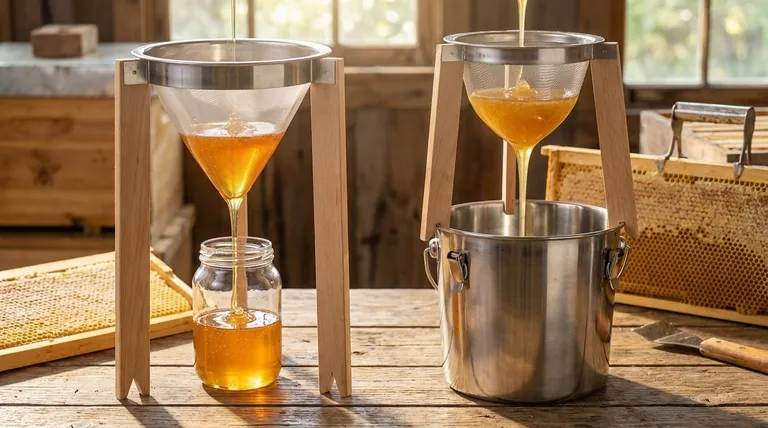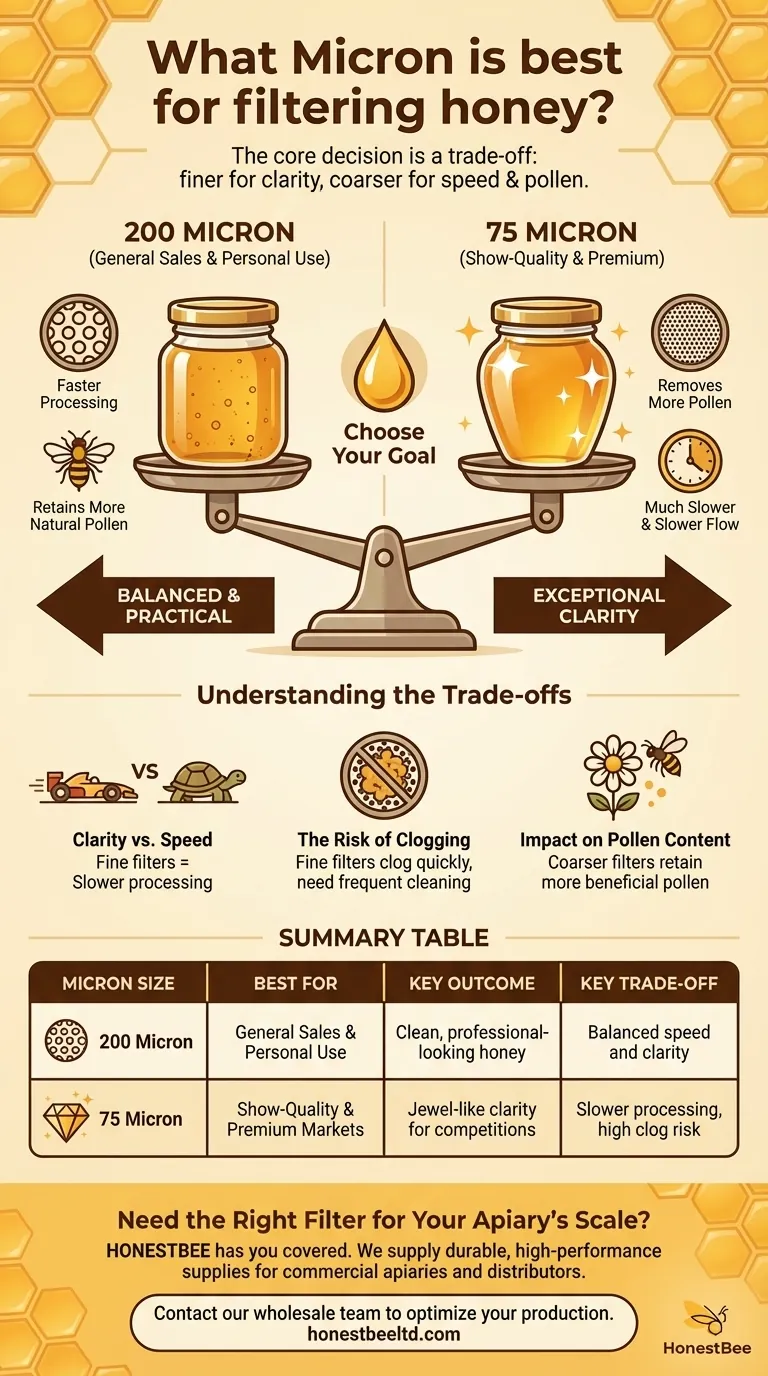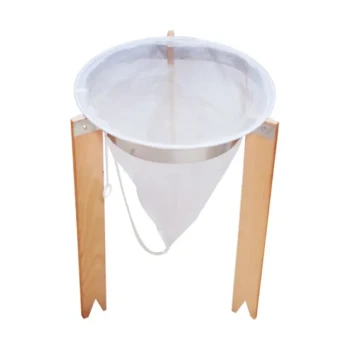For filtering honey, the best micron size depends entirely on your end goal. A 200 micron filter is the most common and practical choice for producing clean honey for general sales and personal use. However, for creating an exceptionally clear, show-quality product, a much finer 75 micron filter is superior.
The core decision in filtering honey is a trade-off: a finer filter (smaller micron number) produces greater clarity for a visually perfect product, while a coarser filter (larger micron number) processes honey faster and retains more of its natural pollen.

Understanding Micron Ratings in Honey Filtering
To choose the right filter, you must first understand what the measurement means and what you are trying to achieve. The goal is to remove unwanted debris while preserving the honey's desirable qualities.
What "Micron" Means
A micron is a unit of measurement equal to one-millionth of a meter. When applied to a filter, it refers to the size of the holes in the mesh.
A smaller micron number means smaller holes, which will trap smaller particles. A larger number means larger, more porous holes.
The Purpose of Filtering
The primary reason to filter raw honey is to remove physical impurities that are unappealing to consumers. This includes wax cappings, bee parts, wood splinters from the hive, and other debris from the extraction process.
Choosing Your Micron Level Based on Your Goal
The "best" filter is the one that aligns with the type of product you want to create. There is no single answer that fits all scenarios.
The 200 Micron Standard (For Sales & General Use)
A 200 micron filter is widely considered the industry benchmark for honey intended for sale or personal consumption.
This level of filtration is fine enough to remove all visible specks and debris, resulting in a product that looks clean and professional. It provides an excellent balance between clarity and processing efficiency.
The 75 Micron Option (For Show-Quality Honey)
For competitions or creating a premium, visually flawless product, a 75 micron filter is the preferred choice.
This will remove much finer, suspended particles, giving the honey a brilliant, jewel-like clarity. The resulting appearance is what judges on a "show bench" look for.
Understanding the Trade-offs
Choosing a finer filter to gain clarity comes with significant practical consequences. You must weigh the benefits against the drawbacks.
Clarity vs. Processing Speed
The most immediate trade-off is speed. Honey is highly viscous, and pushing it through a fine mesh takes time.
A 75 micron filter will be substantially slower than a 200 micron filter. For anyone processing more than a few jars, this can become a major bottleneck.
The Risk of Clogging
Finer filters clog much more quickly. Small particles of wax and pollen will rapidly block the pores of a 75 micron screen, requiring frequent scraping or cleaning.
A 200 micron filter is far more forgiving and allows for larger batches to be processed with less interruption.
Impact on Pollen Content
While filtering removes debris, it can also remove beneficial pollen grains. A very fine filter (like 75 micron) will strip more pollen from the honey than a coarser one.
Some consumers specifically seek out honey with a high pollen content for its perceived local and nutritional benefits, making a 200 micron filter a safer choice for a general market.
Making the Right Choice for Your Honey
Your decision should be a direct reflection of your primary objective for the finished product.
- If your primary focus is clean, clear honey for general sales or personal use: A 200 micron filter offers the ideal balance of effective cleaning and practical processing speed.
- If your primary focus is creating a visually perfect product for competitions or a premium market: A 75 micron filter is necessary to achieve that superior, show-bench clarity.
- If your primary focus is processing large volumes efficiently: Consider a staged filtering process, starting with a coarse 400 or 600 micron pre-filter before finishing with a 200 micron filter.
Ultimately, selecting the right filter is about matching your tool to your specific definition of quality.
Summary Table:
| Micron Size | Best For | Key Outcome | Key Trade-off |
|---|---|---|---|
| 200 Micron | General Sales & Personal Use | Clean, professional-looking honey with good clarity | Balanced speed and clarity; retains more natural pollen |
| 75 Micron | Show-Quality & Premium Markets | Exceptional, jewel-like clarity for competitions | Much slower processing, higher risk of clogging |
Need the Right Filter for Your Apiary's Scale?
Whether you're a commercial beekeeper needing efficient 200-micron filters for large batches or a distributor seeking premium 75-micron options for show-quality honey, HONESTBEE has you covered. We supply durable, high-performance beekeeping supplies and equipment designed for the demands of commercial apiaries and distributors.
Let us help you optimize your honey production. Contact our wholesale team today to discuss your specific filtration needs and volume requirements.
Visual Guide

Related Products
- Professional Honey Filter with Tripod Support Stand
- Professional Cone-Shaped Honey Filter with Reinforced Steel Ring
- Professional Stainless Steel Honey Filter with Support Handle
- Two-Stage Plastic Honey Filter for Buckets
- Nylon Honey Strainer Square Filter Cloth for Honey Filters
People Also Ask
- Why is filtering honey an important step in honey processing? Ensure Purity, Clarity & Marketability
- What is the appearance of filtered honey? A Guide to Clarity, Processing, and Quality
- What is better, a 100 or 200 micron filter? Find the Right Fit for Your Water System
- What is the simple straining method for honey processing? A Guide to Raw Honey for Hobbyists
- Why is filtering honey considered an essential step in honey processing? Ensure Quality and Commercial Viability



















